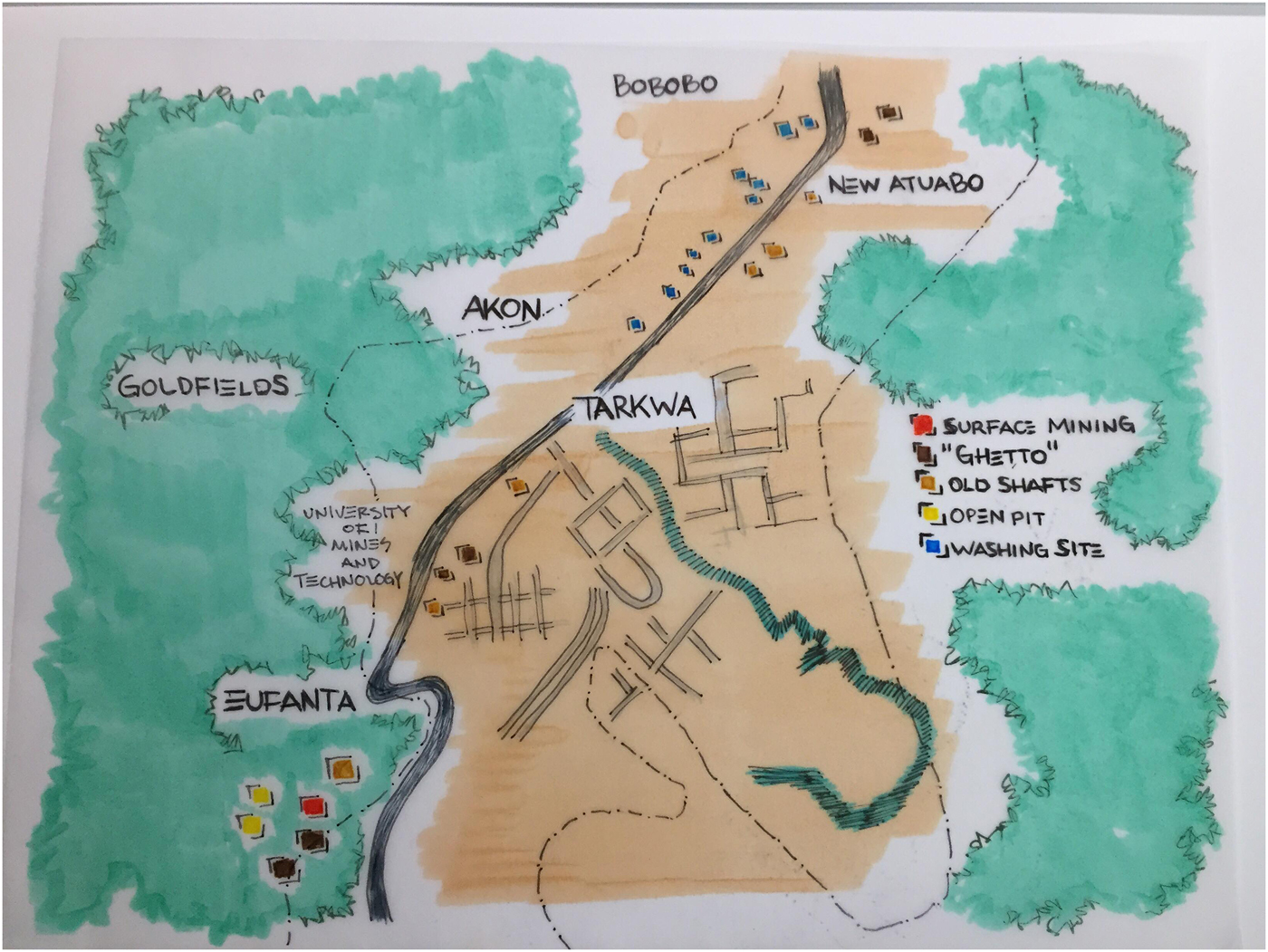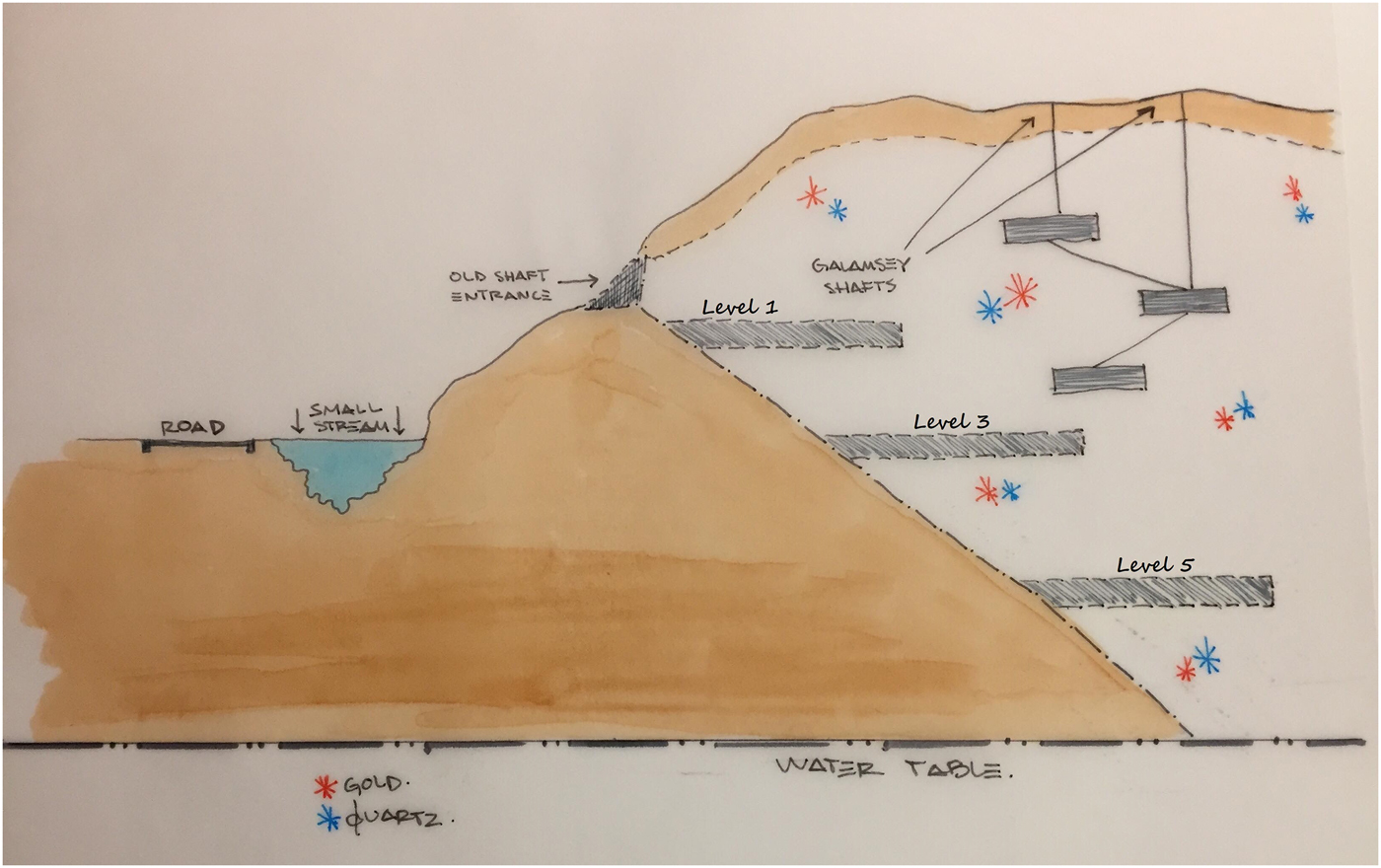At the start of 2017, as Ntewusu (this issue) shows, the Ghanaian government launched an ‘open war’ on illegal small-scale gold miners – galamsey – arguing that Ghana's water bodies and forests need protection. According to Ghana's Water Resources Commission, around 60 per cent of the country's water bodies have been polluted by galamsey activities.Footnote 1 The timing of this ‘war’ is related to the recent trend in which many small-scale mining operations are scaling up their technology as a result of new collaborations, mainly between Ghanaian and Chinese investors and miners.
Our contribution is based on field research conducted in Tarkwa from January to March 2017, a period in which the trend of up-scaling small-scale mining was evident, but when galamsey activities were not yet affected by the government's proclamation of a ‘war on galamsey’. In relation to this specific moment and political context, we ask how the notion of ‘in-depth geopolitics’ can help analyse the tensions and collaborations that had recently developed in small-scale mining and gave a push towards this ‘war’ in Ghana. We build on, but also extend, this notion by foregrounding a particular articulation based on our case study. We look at what we call ‘technologies of collaboration’: articulations of different technical and legal capabilities, which together generate a network of assemblages between different gold-mining actors.
The mining town of Tarkwa, located in the south-west of Ghana, originated as a mining camp in the late nineteenth century and has continued to be one of the most important mining areas in Ghana (Dumett Reference Dumett1998). Today, the city hosts various mining operations (see Figure 1), ranging from large-scale concerns such as the multinational mining corporation Gold Fields, to small-scale and galamsey enterprises that encompass a wide variety of actors and organizational forms.

Figure 1 A simplified depiction of Tarkwa with its different mining sites.
In a manner comparable to that described by Luning and Pijpers (Reference Luning and Pijpers2017) for other sites in Ghana, in Tarkwa small-scale and large-scale mining occur together. However, underground cohabitations take place in a distinctive landscape, marked by a long history of industrial mining. Whereas industrial mining now takes place in open-pit mines, small-scale mining operations often reuse old, abandoned industrial shafts.
The state separates ownership of the land and the subsoil, and, legally, the minerals in the subsoil are state property – what Emel et al. call ‘subterranean sovereignty’ (Reference Emel, Huber and Makene2011). Although galamsey mostly work without state-issued mining licences, they can gain access to sites on the basis of traditional arrangements with the owners of the land. In Tarkwa, engagements in wider socio-political fields can therefore interrupt state–capital alliances (cf. Emel et al. Reference Emel, Huber and Makene2011). In addition, after clearing an abandoned shaft of debris, galamsey miners gain the ‘informal’ right to use it and hence receive informal ownership status. Gaining access to gold results from forms of hybrid governance (Luning and Pijpers Reference Luning and Pijpers2017) and differences in mining technologies (cf. Ribot and Peluso Reference Ribot and Peluso2003).
In small-scale mining, legality and illegality are thus not definite and absolute categories, but produced and contested. Our research in Tarkwa reveals that the definition of illegality is a fluid concept, constructed in practice on the basis of moralities and abilities. Moreover, geological features play a prominent role in this fluid conceptualization. We have seen that small-scale mining can take place in old shafts, where so-called reef mining takes place. In this case, the gold is located in hard rock, and the ore needs to be processed to ‘liberate’ the gold from the stones. On the other hand, gold that has already been freed by processes of erosion can be found near water sources. Mining for ‘free’ gold is called alluvial mining. Both government authorities and small-scale miners agree that alluvial mining is the most destructive to the environment. As a consequence, alluvial mining is categorically considered illegal by all Ghanaians we talked to. We may conclude that illegal mining in the formal sense – defined by the absence of a state-issued licence – differs from the notion of illegality as it is constructed in daily work practices and social arrangements on the ground.
The socio-political structures and construction of legality we found in Tarkwa provide a starting point to explore ‘in-depth geopolitics’: that is, the entwining of the politics of extraction and geological features underground (Luning and Pijpers Reference Luning and Pijpers2017). We situate this within the current trend of up-scaling small-scale mining under the influence of the increasing Chinese presence (see Hilson et al. Reference Hilson, Hilson and Adu-Darko2014; Hess and Aidoo Reference Hess and Aidoo2016; Crawford et al. Reference Crawford, Agyeyomah, Botchwey and Mba2016; Crawford and Botchwey Reference Crawford and Botchwey2017).
One element is key for in-depth geopolitics in Tarkwa: according to the Ghana Mining Act of 2006, only Ghanaian nationals can obtain small-scale mining licences. Therefore, Chinese firms operating in Tarkwa depend on alliances with licensed Ghanaian companies. However, the benefits of these alliances work both ways, since Ghanaian miners often lack technological and financial resources for their operations, and this is what their Chinese partners provide, making it possible to scale up small-scale alluvial and reef mining. In the former, excavators and dredges are used to mine ‘free’ gold on an unprecedented scale; in the latter, water pumps and the rebuilding of transport infrastructure in shafts have enabled drastic changes.Footnote 2 Mining can now take place deeper, even below the water table. In Tarkwa, the networks of assemblages (Weszkalnys and Richardson Reference Weszkalnys and Richardson2014) for gold extraction activities constitute a socio-technical context that may vary and that tends to be site-specific. To illustrate this, we focus on one particular site where reef mining is embedded in recently developed socio-technical alliances: Mohamed & Co.
Two distinct forms of collaboration operate on this site; both centre on Mohamed & Co., the owners of the small-scale mining licence. They partnered with Chinese investors/miners on the one hand, and with various groups of galamsey on the other. Both licensed and galamsey operations mine the same ore body, but differing technological capabilities and geological access lead to contrasting working practices and targeting of the ore from different access points (Figure 2). The licensed operation uses the old shaft infrastructure, which has been rebuilt and improved. Electricity facilitates the use of transport carts in the driveways and extensive systems for pumping out water. Nearby, galamsey are allowed to dig their own pits to access the ore underground, but only until they reach the third level of the underground division, which dates back to the industrial period (see Figure 2). Below the third level, only Mohamed & Co. and its Chinese partners may work, since only this partnership provides the water pumps that are needed to keep the water table down to a certain level. Thus, similar to Luning and Pijpers’ Newmont case, water functions as a barrier for mining in Tarkwa, preventing the galamsey from accessing the richer parts of the ore body.

Figure 2 Cross-section depicting the ground and underground division of Mohamed & Co.
Technologies to bypass this ‘natural’ barrier give the Chinese and their licensed Ghanaian allies exclusive access to the deeper part of the ore body. This is a perfect example of how access to – and exclusion from – underground wealth are connected to technologies of collaboration, based on the legal and technical capabilities of different actors. The case of Mohamed & Co. allows us to understand the influence of in-depth geologies, defined as assemblages of social networks and subterranean features (Luning and Pijpers Reference Luning and Pijpers2017).
The relations between Mohamed & Co. and their two sets of partners thus clearly illustrate the need to consider the infrastructures of extraction and mechanisms of access. In the case of Tarkwa, this is linked directly to the level of technology available to access and extract the ore. Luning and Pijpers state that the governance of access to gold in mining concessions is ‘informed by an intricate combination of social and natural factors: a socio-political field of relations anchored onto an underground of geological structures’ (Reference Luning and Pijpers2017: 6). The case of Tarkwa exemplifies this: the presence of the Chinese and the new technologies introduced as a result affect underground working arrangements. And they do so in a context where legal frameworks identify Ghanaian nationals as gatekeepers to the underground.
In order to reveal these shifting alliances, we have thus proposed to extend the analysis of in-depth geopolitics. We stress the importance of assets owned by alliance partners, especially their legal instruments and technological capabilities. The concept ‘technologies of collaboration’ captures this focus. The example here also shows that we should not look at cohabitation between large-scale and small-scale mining as involving two static categories. The trend of scaling up capabilities due to the arrival of the Chinese and the forging of new alliances increases differentiation among small-scale mining actors. Differences between large and small scale start to be reconfigured, and technologies of collaboration hinge on the fluidity between scales of operation. The way in which the new technologies of collaboration are causing and/or are affected by the ‘war against the galamsey’ continues to be a major issue for research and public debate in Ghana.
Acknowledgements
This paper is based on MA fieldwork carried out under the umbrella of the Ghana Research and Training Programme (FR&T) at the Institute of Cultural Anthropology and Development Sociology, Leiden University, and in collaboration with the engineering firm Witteveen + Bos. A special thanks to Eduardo Saba for helping us give a graphic representation to our descriptions.




